Neil Peart's News, Weather and Sports
Autumn Serenade
NeilPeart.net, November 2009
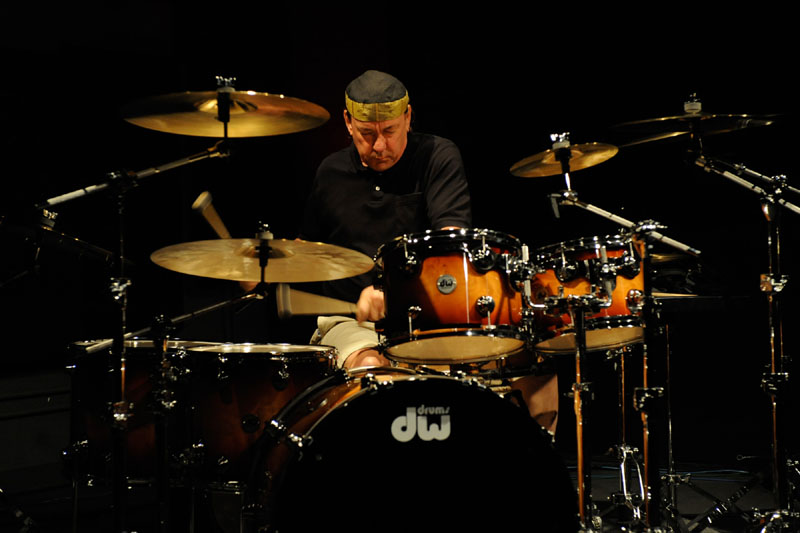
It has been some years since I have been able to play the drums just for the pure enjoyment of it. Not performing or recording, not rehearsing or filming instructional material - just playing. The lack of a drumset at home is one reason, and that is partly because in seismically-active Southern California, basements are rare. Given my rootless nature, I am always ready for the next move, the next home (in just the past nine years, five different homes in California, and three in Quebec), and it always seemed too troublesome and expensive to build the kind of sound-proofed drum rooms my friends Gregg Bissonette and Doane Perry have in their houses, or the cozy and well-equipped teaching studio Peter Erskine has in his back garden.
Another factor in recent years has been that I have spent so much time away from home playing the drums that when I did get back, it was kind of nice to step away completely from the "tools" for a while. If you have drumming in your very pulse, the flow of rhythm in your life is ceaseless, a constant kind of conceptual practicing. (Sitting at a red light, turn indicators set the tempo for an improvised cadenza on the steering wheel.) On the physical side, after forty-four years of playing the instrument, the language of drumming is wired deep in my brain and muscle fibers. So, as one does, I simply adapted to the way things were, and made a virtue of a necessity - "that's how it is, so okay" (a very grownup philosophy indeed). When I needed to rehearse for something, I found other ways - sometimes heading for Toronto a week or two early, or in recent years at the Drum Channel studio, a beautiful hour's drive north along the Pacific Coast Highway, if they had some downtime.
When I studied with Peter Erskine in 2008 (see "The Drums of October"), he restricted me to high-hat and metronome only, so I was able to practice every day without being as anti-social as a full set of drums, even at my house on the lake in Quebec, where sound really travels over the water and through the woods.
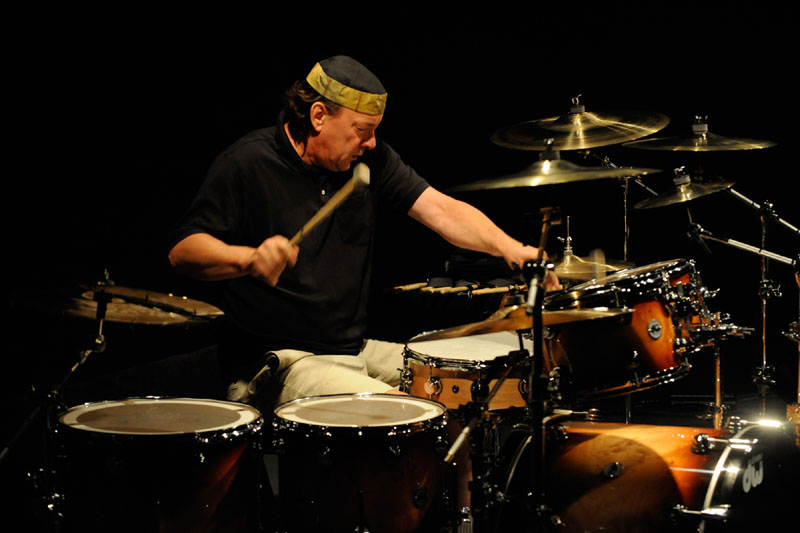
Inevitably, though, at some point I will be overwhelmed by a strong desire to play the drums for real, and that fever came upon me in late summer of this year. As often happens, the urge was sparked by listening to a couple of great drummers: Jack DeJohnette and Ian Wallace. Some musicians react to another player's greatness with envy, or even despair - like Eric Clapton's claim that he wanted to burn his guitar after hearing Jimi Hendrix, or Miles Davis allegedly making Wynton Marsalis want to smash his horn. But for me, hearing another drummer who impresses me (a long list) makes me want to go home and play. That's how it was when I was a kid, and it's still true today - not just an urge to practice and get better, but a response to inspiration.
Quite a few days this summer and fall I have been able to use Drum Channel's studio when it wasn't busy, playing a beautiful practice kit (its finish an autumnal harmony, too) provided by neighbor and benefactor, Drum Workshop. That was how I had that rare luxury of just playing, rambling aimlessly for hours.
These fine photographs of Rob's capture one of my "Autumn Serenades," a lyrical expression with mallets improvised over a relaxed tempo in my beloved 3/4 ostinato (a repeating rhythmic foundation - from the Italian for "stubborn," funnily enough, like "obstinate"). It is my personal adaptation of Max Roach's "The Drum Also Waltzes," and that rhythmic frame remains a comfortable and creative warmup every day, as it has for many years. Slowly, gradually, I moved on to some more recent experiments in rhythm, first with wire brushes (I've had a long secret love affair with brushes, unexpressed professionally as yet - note to self), then with sticks.
I once picked up a quote (though I've never learned its source) that I applied to Buddy Rich: "Genius is the fire that lights itself." It is also true that it is often in the nature of genius to light a fire in others. This year I have been listening to a variety of Jack DeJohnette's incredible span of work over his long and artfully productive career, including a stellar recording called Parallel Realities, with Pat Metheny and Herbie Hancock, and an entrancing duet called Music from the Hearts of the Masters, with Foday Musa Suso, a West African playing the kora (a stringed instrument resembling guitar and harp). Jack DeJohnette bridges the traditional and modern styles of drumming more than perhaps any living player, and his boundless virtuosity and improvisational eloquence lit that fire for me. (I wrote to Jack about the Parallel Realities album: "If I could play like one drummer in the world, it would be like you on that record.")
The late Ian Wallace spent a long and fairly successful career as a journeyman rock drummer, backing a wide range of artists from an early stint with King Crimson in his native England, to touring and recording with the likes of Bob Dylan, Jackson Browne, Don Henley, the Traveling Wilburys, and "the French Elvis," Johnny Hallyday. However, Ian had always wanted to be a jazz drummer, and later in life, he studied with my long-time teacher, Freddie Gruber. Typical of Freddie's other prominent students, like Steve Smith and Dave Weckl, and my own experience with him, one of Freddie's great gifts as a master teacher is that he is a different guide for each of us, according to what we need and want. Thus Freddie guided Ian in becoming the jazz drummer he wanted to be, and Ian's mastery of the style, plus his own confident and original voice, were beautifully evidenced on a CD called King Crimson Songbook, from a project close to Ian's heart, the Crimson Jazz Trio, which interpreted King Crimson songs in a traditional piano, bass, drums format. (Speaking of brushes, check out Ian's dazzling brushwork on "21st Century Schizoid Man.")
Ian was only 60 when he was struck down by cancer (I always have to think of it as stupid cancer, but sometimes only other bereaved survivors understand) in 2007 - just at the moment when he had achieved a lifetime goal of supreme expression on his instrument. He had recently recorded a second CD with the Crimson Jazz Trio, and was planning a tour of jazz festivals for the following year, when all at once, ba-da-boom, it was all over for Ian Wallace. (And people believe in benevolent deities ...)
Ian's widow, Marjorie, and his bandmates Tim Landers and Jody Nardone saw that second CD into production (King Crimson Songbook Volume 2), and my delight in Ian's playing on it is only partly because he was a lovely man with a tragic fate. His command of time, of subtleties of dynamics, facility as a soloist, and faultless accompaniment to the other musicians, all stood as a shining inspiration to me.
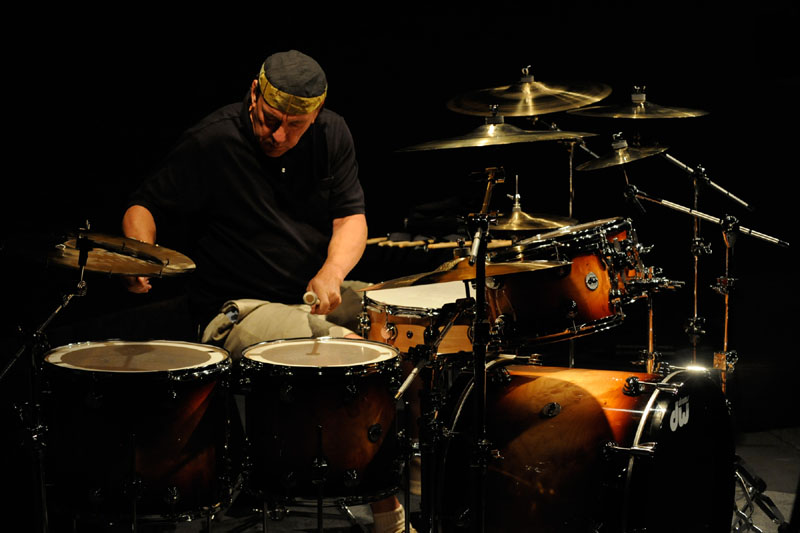
A highlight on that recording was the daring Latin feel Ian applied so successfully to "In the Court of the Crimson King," which inspired me to investigate a rhythmic area that in the past I had only "admired from afar," as it were.
One Big Concept I was determined to work on was a rhythmic approach I have wanted to explore for years, but have always set aside because I knew it would require a lot of time to develop. In the best layman's terms I can muster, it is a hybrid of two rhythmic paradigms: the emphasis on the upbeat or the downbeat. The upbeat tends to drive certain styles of music, like jazz and reggae, while the downbeat is the fundamental language - or at least the accent of the language - in blues and rock. I wondered if they couldn't be combined in a way that didn't shift between one and the other, but actually blended the two, playing both at the same time - what is called a polyrhythm.
F. Scott Fitzgerald once wrote, "The true test of a first-rate mind is the ability to hold two contradictory ideas at the same time." Well, I can't necessarily do that, but with a dedicated sufficiency of time and effort, I have found that my body can express one idea, and my mind the other - for example, after years of practice with the waltz, my feet can sustain a steady 3/4 pattern all day, while my brain directs my hands at improvising with complete freedom, playing absolutely anything, any time signature, any tempo. It took years, but I got there - conquered the ostinato by being obstinate.
The concept this time was to have my left foot keep a constant upbeat, as it would in fast swing music, say, while my right foot and hands would syncopate freely around the downbeat feel of rock and funk music. Sounds simple, and perhaps for some drummers it would be, but for me it was like the waltz had been at first - it was all I could do to keep that high-hat going, and play the simplest figures against it. The critical essence is that both rhythmic accents have to be felt, not just played, so in effect, you have to play two different songs at the same time.
Breakthroughs came slowly, one figure at a time, and along the way I discovered amazing relationships to well-known rhythms in that tension between upbeats and downbeats: samba, various jazz feels, West African patterns, the so-called "second line" style of drumming from New Orleans, and ska and reggae.
And it was so musical. I could play it for hours, because, like the waltz again, to improvise in that pattern was to play a song. An "Autumn Serenade."
The title comes from a big-band hit by Harry James, reflecting the kind of music I've been listening to a lot lately - a satellite music channel called "40s on 4." Artie Shaw, Benny Goodman, Gene Krupa, Buddy Rich, the Dorseys, Duke Ellington, Count Basie, Frank Sinatra, Billie Holiday, and so many great female "band singers," like Jo Stafford, Helen Forrest, Ella Fitzgerald, Eydie Gorme, and Anita O'Day - what a treasurehouse of classic, timeless music. (And a fine soundtrack for cooking at Bubba's Bar 'n' Grill!)
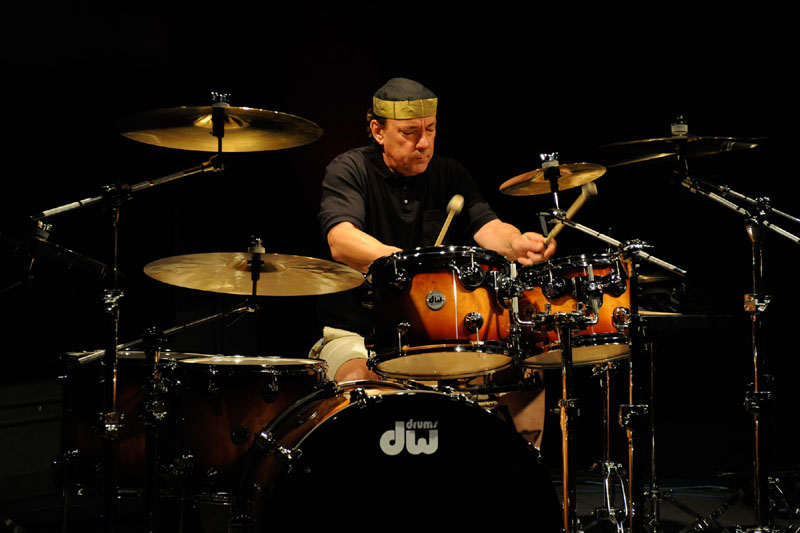
Also, when I started thinking about what I wanted to put into this story, I decided I wanted to make it a song - a serenade for the late summer and autumn of 2009.
"Autumn Rhythm" was another title I considered for my percussion études, and for this story, after a masterpiece by Jackson Pollock, exhibited at the Museum of Modern Art in New York City. Pollock's wife, Lee Krasner, was an important modernist painter in her own right, and she once offered a fundamental distinction that lesser artists often overlooked: "An abstract painting is still of something." I learned to understand that profound quality by experiences like standing before Jackson Pollock's monumental "Autumn Rhythm" in New York, and finally getting it. No reproduction can possibly hint at the effect of works like that, or his "Lavender Mist" at the National Gallery in Washington, D.C. - like Picasso's "Guernica," van Gogh's feverish paint-handling, or major works by the Hudson River school, you have to witness their majestic scale, see the paint, its texture, the lyrical, even sensual power of its application and arrangement on the canvas.
In "Autumn Rhythm," Pollock's gestural arabesques of dripped house-paint and carefully chosen tones and cadences expressed (that's where "Abstract Expressionism" comes from) the feeling of autumn by transcending the observed reality - the mood a representational painter would render in brightly-colored trees and floating leaves on a mill pond (like those great lines from "Moonlight in Vermont:" "Pennies in a stream/ Fallen leaves of sycamore" - more from "40s on 4").
My own favorite "Autumn Rhythm" is found in the Laurentian Mountains of Quebec. The blazing colors of fall foliage are the result of a certain combination of climate, elevation, and varieties of deciduous trees, and their majesty is only fully expressed in the boreal forests - in Canada, the Northeast U.S., Scandinavia, and Siberia. The Laurentians get that formula exactly right on all counts.
It has been quite a few years since I visited Quebec in autumn, and I was very excited about getting up there. I arrived on October 6, just at the "tail of the peak" for the fall colors, before wind and rain brought them down to carpet the forest floor, leaving the stark gray trunks and branches naked against the icy winds to come. The woods all around, and stretching away over the rounded hills behind the lake, were painted in brilliant reds, yellows, and oranges, all flaming among the dark green conifers. As I stood outside and looked around at the radiant beauty, the crisp air fragrant with woodsmoke from my own fireplace, in a silence complete but for the hushed murmur of the stream, I uttered an involuntary, "Oh my."
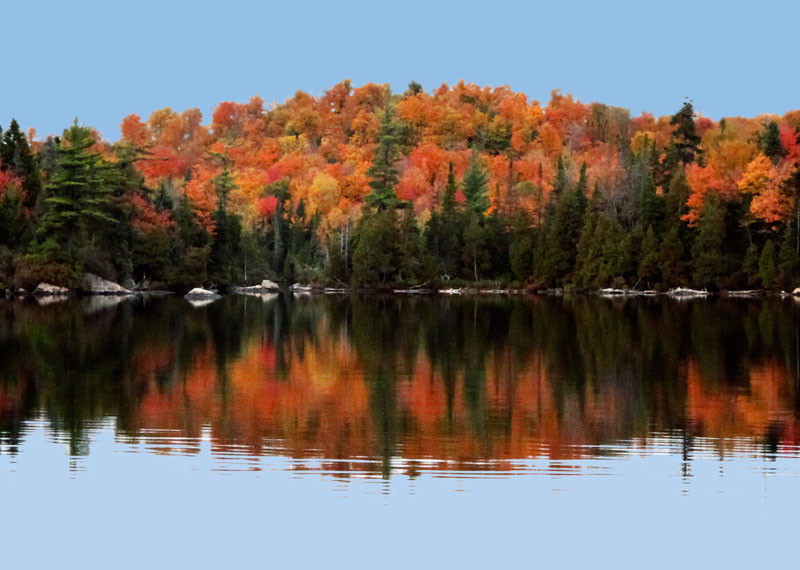
Though my days there were gray and often rainy, the trees still seemed to gather and radiate color and light. Even indoors, the radiance was warm and luminous. Individual leaves of yellow or orange drifted down, turning and wafting like butterflies. An occasional leaf storm whirled about the house, a harbinger of blizzards to come.
Autumn is said to be a season of nostalgia, "pain for a lost home," and in the following rainy days, lazing and reading by the fire, I was reminded of other autumns, especially in that same area. Back in the early '80s, my bandmates and I were recording at nearby Le Studio (working there had introduced me to the Laurentian region, where I have had a home for almost thirty years). The studio's guest house overlooked a small lake, with a steep wooded mountainside rising behind it, and that was the view from our breakfast table. On those brilliant October mornings, we noticed how the colors on that vast canvas of forest changed visibly from one day to the next - a new blaze of red, a flash of orange, a wash of yellow. One afternoon when the studio crew were busy with some technical job, Alex and Geddy and I rowed across the lake and climbed that mountainside, up to where I knew a ski trail crossed its high ridge.
It was a steep climb, but the October air was cool and delicious, and as we struggled upward, clinging to granite boulders and maple trunks, we laughed a lot at our lifetime's worth of shared jokes. Catching our breath at the top, we looked down over the kidney-shaped lake, with the guest house at one end and the studio at the other, then far away south over the low, rolling mountains in their polychrome paint.
I took out my Swiss Army knife and started carving our new band name into the smooth gray bark of a beech tree. It has long been our habit to invent sub-groups that encourage us to write and play in a different character than "us," and the early '80s version was a new-wave outfit called The Fabulous Men (responsible for such songs as "Vital Signs" and "Digital Man").
Another favorite sub-group was Rockin' F, which was more of a roots-rock combo, and often applied as an adjective: "That's Rockin' F!" Masquerading as Rockin' F gave us things like the second verse of "The Spirit of Radio," the verses of "Force Ten," "Dog Years," and "Spindrift." (Riding through the Texas Hill Country on a hot July day last summer, I laughed to see a ranch called the Rockin' F - and later regretted not stopping to take a photo. I think it was just too hot.)
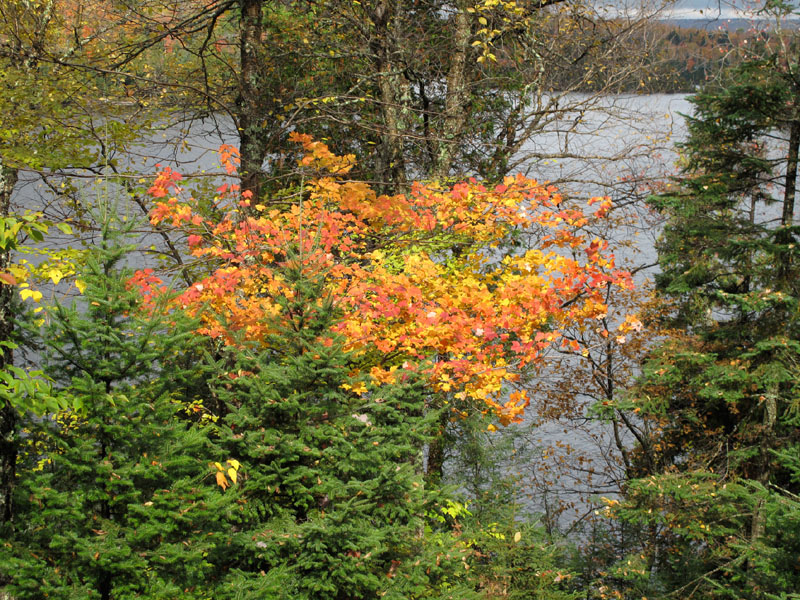
Somewhere up on that mountain in Quebec, along the Portageur ski trail, there's a beech tree with "The Fabulous Men" carved into it (if it hasn't grown over or fallen down in over twenty-five years).
In this autumn of 2009, the three of us are poised on another kind of "reinvention." We have agreed to meet in Los Angeles in November, and discuss our future. We learned many years ago that when we finish one long project - like a two-year tour following a year or so of writing and recording for Snakes and Arrows - we don't make any further plans for a while. It's good to feel truly free for a time, and to clear your mind to focus on what you'd really like to do next.
Of course, these are parlous times in the music business, so our time-honored pattern of touring, recording, and touring is no longer the obvious way to do things. The music world - or at least the business of it - is very different now, even since 2006, when we began work on Snakes and Arrows. The importance of "the album" is not what it was, and there is currently a reversion to a musical climate rather like the 1950s, when only "the song" matters. Radio, downloads, and "shuffle" settings are inimical to collected works. Because of that reality, record company advances that used to pay for album projects are a thing of the past, so if that was what we wanted to do, we'd be on our own.
"Crisis is both danger and opportunity," goes the Chinese saying, and rather than lamenting the passing of the old way, we will figure out how to work with how things are now. In Nelson Algren's The Man With the Golden Arm, Frankie Machine explains to Sparrow why their neighborhood, and their lives, are going to hell: "That's just the new way of doin' things we got these days."
A resigned irony is conveyed there, and it applies to my feelings about some of the changes going on around us. It may not be the way we would choose, but I defer to a favorite expression of Professor Gruber's, drawn from a worldview dating from his childhood in the Bronx in the 1930s: "It is what it is."
I have been surprised to see that phrase mentioned as the "most hated" by some people, when I think it expresses a simple practicality of making the most of the current reality, not getting all exercised by what can't be altered. As stated earlier, "That's how it is, so okay."
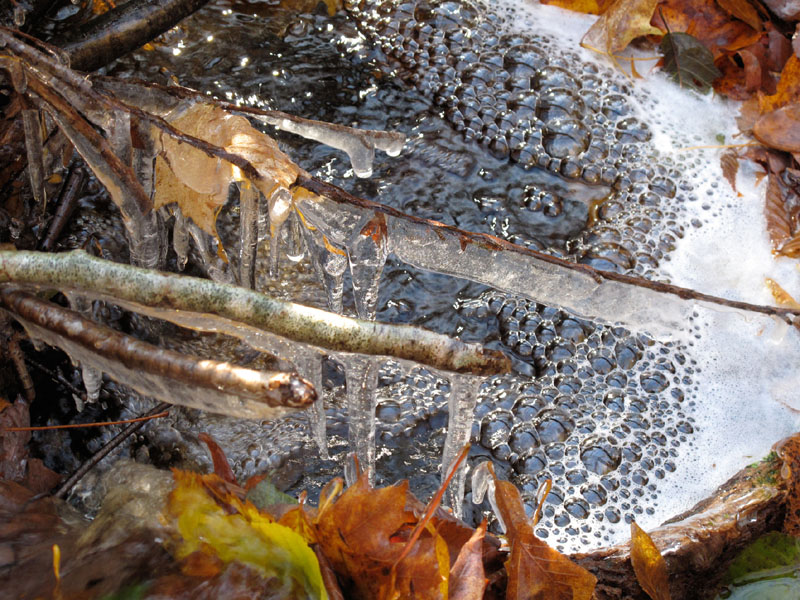
The German philosopher Ludwig Wittgenstein gave this definition of reality: "The world is all that is the case." Typical of philosophical aphorisms, it is a deep little statement, but it certainly includes the idea that "It is what it is." I guess idealists ("It's not what it ought to be"), paranoids ("It's not what it seems"), cynics ("It is, but not very"), reactionaries ("It's not what I want it to be"), self-deluders ("It's not my is"), and rationalizers ("It's not my fault"), would have trouble with that concept.
To this point, the three of us haven't even discussed what we might discuss, so to speak - so our ideas and shared enthusiasm for the entity of Rush will be fresh, spontaneous, and quite likely exciting. For myself, I'm open to anything we can all agree on (I've pointed out before that in a three-piece band, we need consensus, not democracy - it's no good having one outvoted and unhappy member). My favorite group activity is always songwriting and recording, and I've got some lyrical ideas and those new drumming frontiers to explore. However, those rhythmic concepts would also be inspiring for a new drum solo, if we decided to do a tour of some kind, maybe with an orchestra. We could write and record just a few songs, and release them some way. Or there were a couple of film-and-music projects we had discussed in the past. In any case, there are enough possibilities for future collaboration, and I am curious to see what we'll come up with.
Meanwhile, I'm watching the October rain fall, warmed by a blazing fire, and as always, delighted by the steady flight of visitors to my bird-feeder, Bubba's Seeds 'n' Suet. There's the inevitable cheerful throng of chickadees, occasional crack-head mobs of bluejays, a red-breasted nuthatch, downy woodpecker, hairy woodpecker, a few charcoal-gray juncos feeding on the ground, and some birds that are uncommon in winter, like white-crowned sparrows and goldfinches, probably stocking up before they move farther south. The finches are already fading from their brilliant yellow and black summer plumage to the dull buffy outfits they wear in winter. The first time I saw a goldfinch in its winter colors, I drove myself mental trying to identify it, until I found that season's wardrobe illustrated in the big Birds of Canada book.
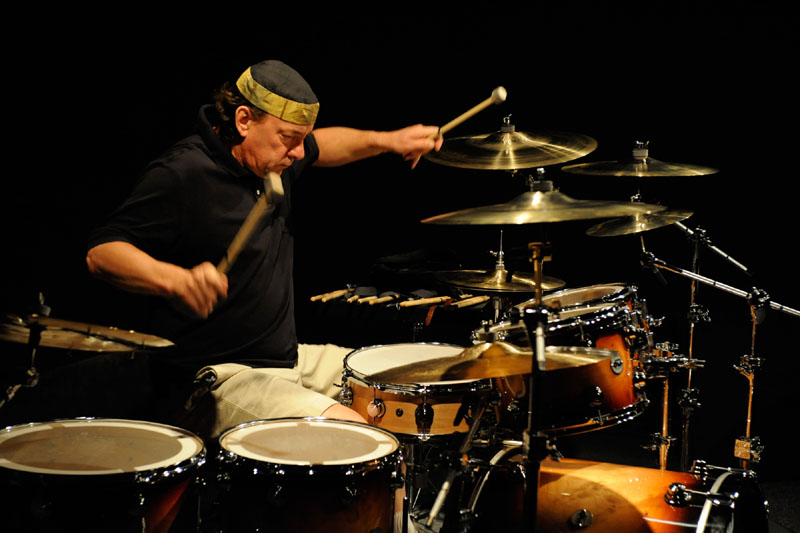
My gallery of picture windows frames a series of watercolors of the autumn woods, vibrant hues subdued and softened by a wet gray haze. The rain on the metal roof is a delicate pattering of wire brushes on a snare drum, the fire a hiss and murmur of mallets on a cymbal, syncopated by sparks and snaps in a polyrhythmic Latin flourish.
Johnny Hartman sings the Harry James standard on "40s on 4":
Let the years come and go
I'll still feel the glow
That time cannot fade
When I hear that lovely autumn serenade